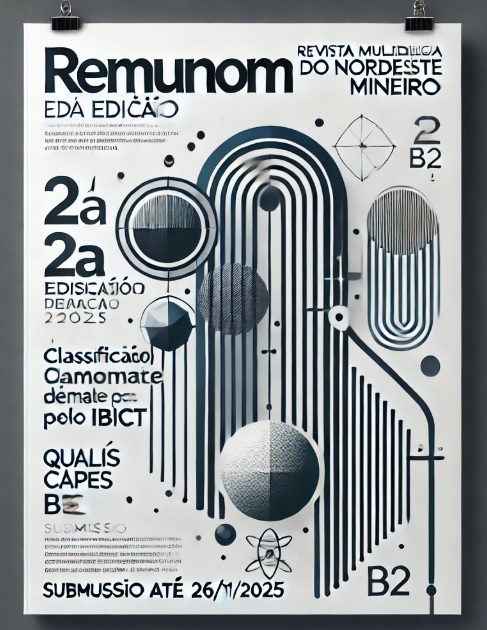A INFLUÊNCIA DA GENÉTICA E DA HEREDITARIEDADE NAS HABILIDADES DOS PERSONAGENS DO ANIME NARUTO SHIPPUDEN
considerações para o ensino de Biologia
DOI:
https://doi.org/10.61164/remunom.v1i1.3447Keywords:
Alelismo. Dominância. Recessividade. Mutações Genéticas. Clãs.Abstract
The anime and manga series Naruto Shippuden, created by Masashi Kishimoto, is rich in elements that can be analyzed from the perspective of genetics and heredity. The narrative covers families and clans with unique abilities that are passed down from generation to generation, offering a fascinating scenario to explore scientific concepts of genetics. This study investigated the influence of genetics and heredity on the abilities of characters in the anime Naruto, making detailed comparisons with real scientific principles. The research aimed to understand how genetic and hereditary concepts are represented in the fictional narrative and how these representations can be used as effective educational tools in teaching natural sciences. The analysis identified several main clans in Naruto, such as the Uchiha, Hyuga, and Uzumaki clans, and their specific hereditary abilities. The application of genetic concepts such as alleles, dominance, and recessiveness showed how Mendelian genetics can explain the transmission of these abilities. Genetic mutations, such as the Mangekyō Sharingan and the Rinnegan, were identified, which confer extraordinary abilities to the characters. Furthermore, the research explored natural selection and evolution observed in the different clans and their abilities, highlighting how environmental and social pressures influence the propagation of advantageous traits. Comparing heredity in Naruto with real examples of genetic inheritance in humans revealed similarities and differences, providing a richer understanding of genetic principles. In conclusion, integrating Naruto into the teaching of genetics and heredity offers a unique opportunity to enrich Biology learning. Using elements of pop culture as a pedagogical resource can create a dynamic, inclusive, and engaging learning environment, promoting a deeper understanding of scientific concepts and preparing students to be critical thinkers and scientifically literate.
Downloads
References
FUTUYMA, D. J. (2013). Evolution. Sinauer Associates, Inc.
GRIFFITHS, A. J. F., WESSLER, S. R., CARROLL, S. B., & DOEBLEY, J. (2000). Introduction to Genetic Analysis (8th ed.). W. H. Freeman.
HARRIS, M. S. (2000). Using Popular Media to Teach Genetics. In New Directions for Teaching and Learning, 81, pp. 73-78.
HARTL, D. L., & JONES, E. W. (2009). Genetics: Analysis of Genes and Genomes (7th ed.). Jones and Bartlett.
KISHIMOTO, M. (1999). Naruto. Shueisha.
PIERCE, B. A. (2013). Genetics: A Conceptual Approach. Macmillan Learning.
STRACHAN, T., & READ, A. P. (2010). Human Molecular Genetics (4th ed.). Garland Science.
STRICKBERGER, M. W. (1996). Evolution.
JONES & BARTLETT. The Naruto Saga: The Unofficial Guide. (2007). DK Publishing.
Downloads
Published
Issue
Section
License
Copyright (c) 2025 REMUNOM

This work is licensed under a Creative Commons Attribution-NonCommercial-ShareAlike 4.0 International License.
Autores que publicam nesta revista concordam com os seguintes termos:
- Autores mantém os direitos autorais e concedem à revista o direito de primeira publicação, com o trabalho simultaneamente licenciado sob a Licença Creative Commons Attribution que permite o compartilhamento do trabalho com reconhecimento da autoria e publicação inicial nesta revista;
- Autores têm autorização para assumir contratos adicionais separadamente, para distribuição não-exclusiva da versão do trabalho publicada nesta revista (ex.: publicar em repositório institucional ou como capítulo de livro), com reconhecimento de autoria e publicação inicial nesta revista, desde que adpatado ao template do repositório em questão;
- Autores têm permissão e são estimulados a publicar e distribuir seu trabalho online (ex.: em repositórios institucionais ou na sua página pessoal) a qualquer ponto antes ou durante o processo editorial, já que isso pode gerar alterações produtivas, bem como aumentar o impacto e a citação do trabalho publicado (Veja O Efeito do Acesso Livre).
- Os autores são responsáveis por inserir corretamente seus dados, incluindo nome, palavras-chave, resumos e demais informações, definindo assim a forma como desejam ser citados. Dessa forma, o corpo editorial da revista não se responsabiliza por eventuais erros ou inconsistências nesses registros.
POLÍTICA DE PRIVACIDADE
Os nomes e endereços informados nesta revista serão usados exclusivamente para os serviços prestados por esta publicação, não sendo disponibilizados para outras finalidades ou a terceiros.
Obs: todo o conteúdo do trabalho é de responsabilidade do autor e orientador.






